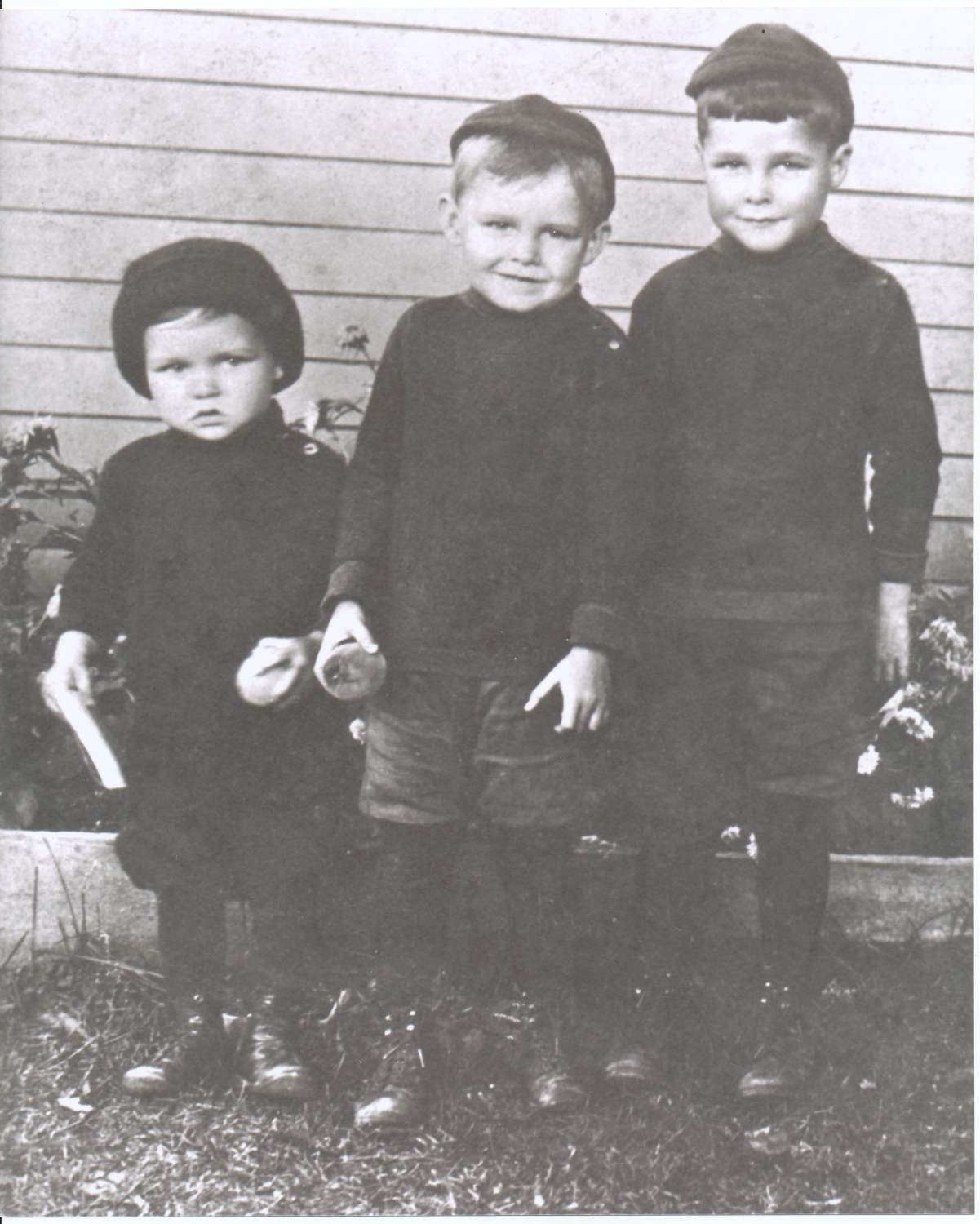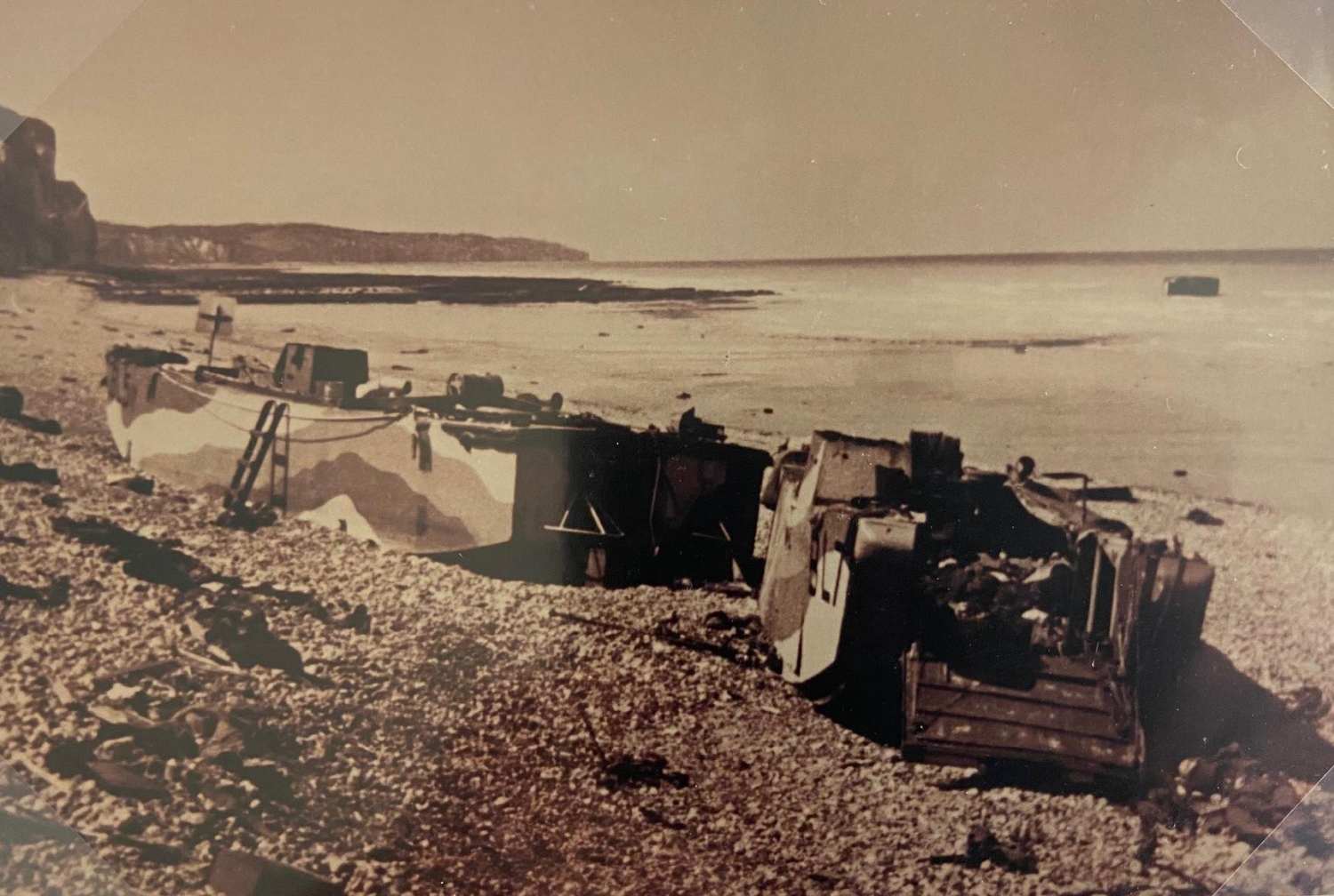Edwin Bennett
Edwin Bennett
The life story of Second World War veteran Ed Bennett.
By Liz Dommasch, Archivist
Born in Woodstock in 1913, Edwin (Ed) Bennett was involved in the cadet corps throughout his school years and attended Woodstock Collegiate where he excelled on several high school championship football and hockey teams. On December 10, 1931, he was a member of the Woodstock Grads when they won the Canadian Junior Rugby Football championship defeating the Moose Jaw Maroons, by 14-13.

Ed Bennett with his brothers.
In 1933, he married his childhood sweetheart Lee (Leota Lounsbury) and a year later Lee helped found the Woodstock Little Theatre where Ed worked behind-the-scenes constructing sets and raising funds to support its productions.
In 1940 while working for the C.P.R. express in Woodstock, Ed joined the A.T.S. of the Oxford rifles as a sergeant instructor, and later was promoted to the rank of regimental sergeant major. When the camp at Thames Valley closed he obtained his release from the county unit and went to Brockville for an officer’s training course. Upon being awarded his commission, he was posted to the Canadian Armored Corps and went to Camp Borden for further training and where he received the rank of Lieutenant. In late 1941 he was sent overseas to the Canadian Armored Corps Reinforcement Unit, then to the 1st Canadian Army Tank Brigade where he opted to join the Alberta-based Calgary Tanks because “[he] knew those Western farm boys could fix anything, and they sure could fix tanks.” He later said it was a “fateful” decision because the Calgary Tanks was the only tank unit to go to Dieppe.

Ed Bennett in uniform with his wife Lee.
On August 19th, 1942 Ed commanded three tanks (Beefy, Bloody, and the Bellicose and each with a crew of five) with the 14th Canadian Army Tank Regiment of Calgary in the raid on Dieppe. He was 28 years old. Before reaching the beach, his landing craft was hit and a hydrogen cylinder blew up behind him sending burning fuel across the back of his tank and blinding him in one eye, and burning his face and hand. Despite his injuries, he climbed into his tank and led his section of the Calgary Tank Regiment ashore. His tank nicknamed the Bellicose made it past the seawall and onto the esplanade where German roadblocks prevented him from going further. Upon his return to the beach, the Bellicose was immobilized when a shell ripped apart its left track. Ed and his crew abandoned the tank and found shelter behind a beached landing craft with other troops while waiting for boats to escape from the beach.

Landing craft sitting on the beaches of Dieppe.
When the first boats arrived, Ed and his crew opted to wait and it was this decision that may have saved his life. As the Canadians ran to the boats, many were cut down by enemy gunfire. Others died when their boats were hit pulling away from shore. By this time both his eyes were swollen shut from the burns he received. He and other Canadian soldiers were taken prisoner by the Germans and were marched through Dieppe. Those requiring medical attention were loaded onto boxcars for transport to Rouen, while others were transported to various German POW camps. It is at the hospital facility at Rouen, where he met Sister Agnes-Marie Valois, one of the Augustine nuns there to help him and his Canadian comrades, and where he would receive medical treatment for his injuries.
After a brief stay at the hospital camp in Rouen, Ed was sent to another camp in a place called Kloster Haina (a mental institution before and after the war), which specialized in POWs blinded as a result of wounds. He would remain there until April 1943, when he was sent to a regular POW camp at Rotenburg-am Fulda. It took 73 days for Ed’s wife Lee to receive the official telegram confirming that her husband was being held prisoner. Fortunately, she had found out a couple of weeks earlier through a friend in England that Ed had written to following his capture. In 1944 Ed was one of those selected for prisoner exchange and was sent for two months to a repatriation camp. From there he and the other soldiers were sent to neutral Sweden before returning to England in exchange for German prisoners returning to Germany. Once in England, he was able to join his wife Lee who had been working as a Red Cross transport driver in London since August 1943.
Since Ed was no longer required to return to active duty, Len Taylor, who worked at the Minister of Information, was able to facilitate getting him a job at SHAEF (Supreme Headquarters Allied Expeditionary Force) as a photo film censor. Ed loved this job (“[he] was the only one-eyed film censor in the Allies”) and was eventually promoted to Staff Captain from Lieutenant. In 1945 as a member of SHAEF Ed returned to Dieppe for the first time. On that journey, he made lifelong friends with the Amourette and Rasset families and since that trip, returned to Dieppe almost every five years for the anniversary of the raid.
In 1979, Ed appeared in, and was an advisor for, the CBC film documentary, “Dieppe 1942”. Filmed in September 1978, the documentary describes the raid on Dieppe and its aftermath including the experiences of those who became prisoners of war. Following its filming, Ed made a friend of a former enemy, a German veteran who he met during the shoot, and who he corresponded with regularly afterward.
On return to Woodstock in 1945, Ed began work for Coles Brothers Insurance Company, where he became a General Manager until his retirement in 1979. One of his first jobs on joining Coles in 1945 was to sell $50 Victory Loans Bonds. According to rumour, Ed even climbed on top of cars to stick posters up on lampposts. At the Victory Dinner on November 20, 1945, Ed received a special award for the campaign salesman who had shown the most originality, persistence, and energy.

Portrait of Ed Bennett taken while he was an employee at Coles Brothers Insurance.
During his business career, Ed was for some years a Director of the Woodstock & District Chamber of Commerce and a director of the Oxford County Red Cross Society. In addition, he was a founding member of the Woodstock Ski Club and a secretary of its board; a director of the local Craigowan Golf Club, and a Chair of the Woodstock Arena Board and Recreation Commission.
Since his teens, Ed was an active member of the Woodstock YMCA, and 67 years, after joining was awarded a lifetime membership. He was an organizer and founding member of the Men’s Club at the ‘Y’ and a Men’s Club president from 1949-1950. Throughout his life, Ed followed the values of the three-sided triangle of the YMCA – body, mind, and spirit and because of this, Ed will always be remembered for his kindness to others and strength of character.
As Ed neared retirement, his business activities lessened, leaving him enough free time to actively follow up his lifelong interest in local history. In 1970, he began over 30 years of volunteer work to promote and preserve local heritage. He joined the Oxford Historical Society, becoming a member of its committee in 1971. In 1974 he became 1st Vice President of the Society, its President in 1977 for seven years, and its Honorary President from 1989 until the time of his death. Under Ed’s Leadership, a Historic Plaques Committee was organized consisting of a 3-person task force that represented both the Woodstock and District Chamber of Commerce and the Oxford Historical Society. Between 1973 and 1979, the Committee successfully put up historical plaques at 18 locations across the city. In addition, Ed was instrumental in the publication of Brian Dawe’s Book “Old Oxford is Wide Awake”, an early history of Oxford County, and in the preservation of the Oxford County Jail, now the Oxford County Board of Health.
In 1980 Ed began his most ambitious public service project when he helped establish and co-chair the Joe Boyle Repatriation Committee with Len Taylor. In 1983 following several years of arduous but successful efforts, the Committee was able to repatriate the body of Joseph W. Boyle from Hampton Hills, England, where he was buried in 1923 following his death, to Woodstock where he is now interned at the Presbyterian Cemetery.
Ed Bennett passed away at Parkwood Hospital, London on November 11, 2010. He was 97 years old.
Image credits: COA44 Edwin Bennett fonds
